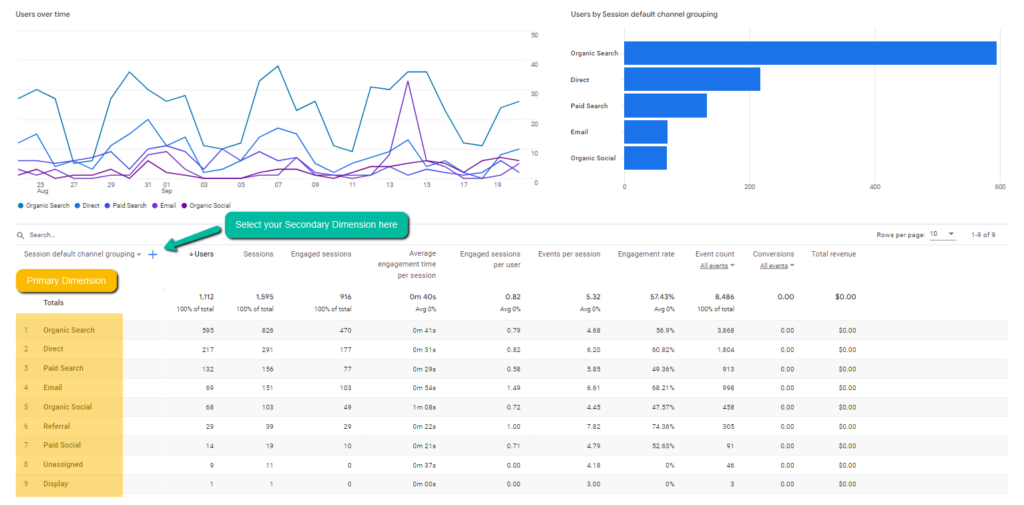Step-by-Step Guide: Leveraging Secondary Dimension in Google Analytics
Step-by-Step Guide: Leveraging Secondary Dimension in Google Analytics
Blog Article
Unlock Deeper Insights With Secondary Measurement in Google Analytics
With the vast area of data offered in Google Analytics, the usage of second dimensions can considerably enrich your logical abilities. These additional layers of data use a nuanced point of view that can brighten elaborate details within your key metrics. By strategically integrating secondary dimensions into your analysis, you can uncover important understandings that might otherwise continue to be undiscovered. The ability to interpret and divide customer habits with greater precision opens a realm of opportunities for maximizing methods and enhancing efficiency.
Comprehending Main Vs. Secondary Dimensions
On the various other hand, additional measurements allow you to more dissect your main measurement data. By including a secondary dimension, you can layer on additional information to your main dimension, enabling a more granular evaluation. If your primary dimension is the source/medium with which customers showed up on your website, including a secondary measurement like geographical place can reveal where those users are located geographically.
Using Additional Dimensions Properly
Effectively making use of secondary measurements in Google Analytics enhances the depth and granularity of data evaluation, providing important understandings right into customer actions and patterns. By including additional dimensions together with main measurements, marketing experts and experts can dive deeper right into the specifics of user interactions on their web sites. Secondary dimensions allow customers to sector and filter key measurement information even more, offering a more thorough view of user interactions, demographics, and actions. This can be specifically useful when attempting to recognize the effect of details variables on individual involvement, such as the web browsers or gadgets they are utilizing, the sources of their traffic, or their geographical locations.
In addition, additional measurements make it possible for users to contrast and contrast different data points within a solitary report, helping with an extra extensive analysis of individual actions patterns. By leveraging additional dimensions efficiently, services can discover concealed understandings, enhance their marketing methods, and boost the total customer experience on their websites.
Checking Out Usual Second Measurement Mixes
To better evaluate individual actions and fads in Google Analytics, it is important to check out usual mixes of second measurements. By integrating various secondary measurements, marketers and experts can acquire deeper insights into just how different aspects impact and engage website performance. Some typical second dimension combinations that give useful understandings consist of examining traffic sources with user areas to recognize where website visitors are coming from geographically and just how they found the website. Integrating landing pages with devices can disclose which web pages carry out best on different tools, helping in enhancing the website for better user experience. Furthermore, taking a look at individual habits metrics with second measurements such as rate of interests or demographics can assist in targeting particular audience sectors a lot more efficiently. By checking out these common secondary measurement mixes, companies can uncover covert patterns, determine chances for improvement, and make data-driven decisions to enhance their on-line visibility.
Using Secondary Measurement in Customized News
Using secondary dimensions in custom-made records enables a much more thorough analysis of information in Google Analytics, boosting the deepness of insights obtained. When creating custom-made records in Google Analytics, integrating additional measurements can give a much more thorough sight of how numerous dimensions communicate with each various other. This function enables individuals to dig much deeper right into their data and discover beneficial correlations that might not be instantly evident.
By using second dimensions in personalized records, customers can get a much better understanding of their web site or app traffic. For instance, integrating the primary dimension of "source/medium" with the second dimension of "landing page" can expose which touchdown web pages are performing finest for Clicking Here traffic coming from specific sources. This understanding can assist marketers maximize their campaigns and improve total conversion prices.

Enhancing Data Visualization With Additional Dimension
When exploring data in Google Analytics customized reports, incorporating second dimensions not only supplies an extra in-depth evaluation but also enhances the aesthetic depiction of insights via information visualization. By adding a secondary measurement to your reports, you can enhance the way data exists, making it simpler to determine patterns, trends, and relationships within your web site's efficiency metrics.
Second dimensions can assist you section your information further, allowing for a much deeper understanding of user habits and interactions on your website. When attempting to isolate particular variables that might affect your website's performance., this boosted degree of granularity can be specifically useful.

Conclusion
To conclude, leveraging additional dimensions in Google Analytics enables an extra extensive analysis of data, resulting in deeper insights and even more educated decision-making. Secondary Dimension in Google Analytics. By including added layers of information to main data sets, marketing professionals and experts can discover covert patterns, patterns, and relationships that offer a granular view of user actions and interactions. This enhanced level of insight makes it possible for optimization of projects and tailored More about the author approaches for particular target market sections, inevitably boosting performance and conversion rates
On the various other hand, secondary dimensions allow you to further dissect your main measurement information. By including an additional measurement, you can layer on added info to your main dimension, making it possible for a much more granular evaluation. If your main measurement is the source/medium through which users got here on your site, adding an additional measurement like geographic location can reveal where those users are situated geographically. By integrating second measurements along with key dimensions, experts and online marketers can dig deeper right into the specifics of user interactions on their web sites. Second measurements permit customers to sector and filter key measurement information even more, using an extra thorough view of individual interactions, demographics, and behaviors.
Report this page